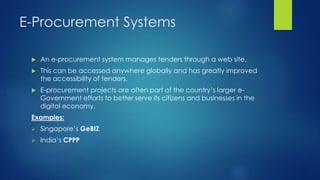E procurement
- 2. What is E-Procurement? E : Electronic Procurement : the process of obtaining supplies, especially for an government or organization E- Procurement : the business-to-business purchase and sale of supplies and services over the Internet. Also Known as: Supplier Exchange Definition: E-procurement is the business-to-business purchase and sale of supplies and services over the Internet. • An important part of many B2B sites. Typically, e-procurement Web sites allow qualified and registered users to look for buyers or sellers of goods and services. • Depending on the approach, buyers or sellers may specify prices or invite bids. Transactions can be initiated and completed. • Ongoing purchases may qualify customers for volume discounts or special offers.
- 3. E-Procurement Vs Traditional Procurement Traditional Purchasing Need Inform purcha- sing Department Get Approval Create Purchase Order Receive in one week Request for quotation Get Approval Internet purchasing Need Search approved electronic catalog order Receive in 2 days Approve online
- 4. E-Tools that replace traditional procurement E-sourcing supports the specification phase; it identifies suppliers that can be used in the selection phase. E-tendering supports the selection phase; it facilitates the REOI and ITB/RFP activities, usually including support for the analysis and assessment activities. E-reverse auctioning supports the contract phase; it enables closing a deal with a supplier; E-ordering and web-based ERP is the process of creating and approving procurement requisitions, placing purchase orders, as well as receiving goods and services ordered, by using a software system based on the Internet. E-informing is not directly associated with a phase in the procurement process; it is the process of gathering and distributing procurement information both from and to internal and external parties using Internet technology.
- 6. Elements of e-procurement request for information request for proposal request for quotation RFx ( Previous 3 together)
- 7. The e-procurement value chain consists of: indent management: workflow involved in the preparation of tenders e-Tendering, e-Auctioning, vendor management, catalogue management, Purchase Order Integration, Order Status, Ship Notice, e-invoicing, e-payment, contract management
- 8. E-Procurement Systems An e-procurement system manages tenders through a web site. This can be accessed anywhere globally and has greatly improved the accessibility of tenders. E-procurement projects are often part of the country’s larger e- Government efforts to better serve its citizens and businesses in the digital economy. Examples: Singapore’s GeBIZ India’s CPPP
- 9. E-Procurement Tools (Software) E-procurement software may make it possible to automate some buying and selling. Companies participating expect to be able to control parts inventories more effectively, reduce purchasing agent overhead, improve manufacturing cycles. E-procurement is expected to be integrated with the trend toward computerized supply chain management.
- 10. E-Procurement in Application E-Procurement is a fully capable electronic web application for purchasing goods and services. E-Procurement allows shoppers to browse online catalogs, add items to a shopping cart and submit the requisition electronically. Orders may also be created manually for complex purchases of capital equipment and professional services. Completed requisitions are routed for review or approval via electronic workflow. Requisitions to select suppliers included in the hosted "e-Catalog" will automatically generate purchase orders and transmits them to the suppliers. All other approved E-Procurement requisitions are routed to purchasing agents for Procurement review and processing into purchase orders.
- 11. E-Procurement tools and applications Includes: electronic systems to support traditional procurement EDI (electronic data interchange) ERP systems internet as a support or complement to traditional procurement electronic mail (e-mail) web enabled EDI extensible markup language (XML) world wide web (www) internet tools and platforms that replace traditional procurement
- 12. E-Procurement Benefits The primary benefit that, government agencies, service providers, and industry seek to achieve from implementing electronic procurement (e.g. e-Tender) is to reduce the liable cost of business and to deliver services that are more efficient for the community. e-Tendering is a key strategy in the development of various electronic procurement programs and initiatives, offering additional opportunities for industrial businesses, contributing to a globally competitive economy, and helping secure a sustained economic growth
- 13. General Benefits Streamlines the whole tendering process. Provides improved and secure access to tender information. Brings about innovative business processes. Initiates greater opportunities for small and regionally based businesses. Allows downloading of electronically submitted tenders in a form suitable for evaluation purposes without having to manually re-enter data. Makes it easier for businesses to obtain tender documentation and to submit Cost Effective, Fast and Efficient
- 14. E-Procurement Risks missing opportunities to implement strategies that improve procurement management without the need for investment in e-procurement: because many of the benefits ascribed to e-procurement may be achieved simply by improving procurement practice. over-investment in e-procurement tools that do not deliver the expected benefits: arises when there has been inadequate evaluation of the implications of the adoption or enhancement of e-procurement tools. The risk that users will not accept an e-procurement tool is another common risk. This risk often arises where users have not been adequately consulted about the adoption or enhancement of particular tools. On the supply side, there is a risk that suppliers will not cooperate with the use of e-procurement tools. For example, some suppliers are sufficiently powerful to insist on the use of paper-based systems. Others may not have access to affordable internet based technology that would give them access to the e-procurement tools of purchasers. In markets that are already competitive with low profit margins, suppliers may choose not to participate in e-reverse auctions. Normal methods of risk assessment and management should be applied during the development of business cases for e-procurement development or enhancement.














